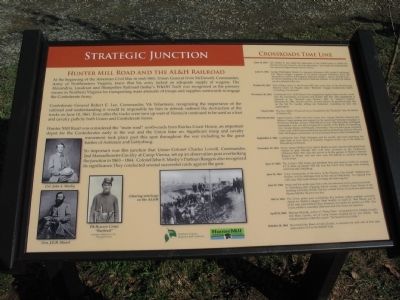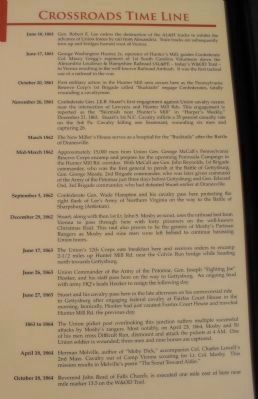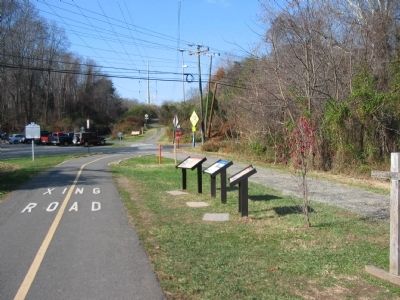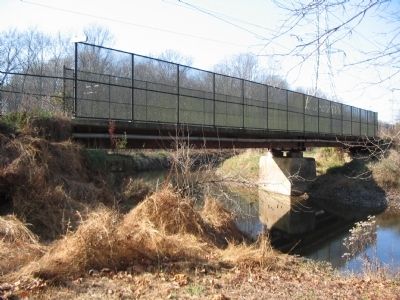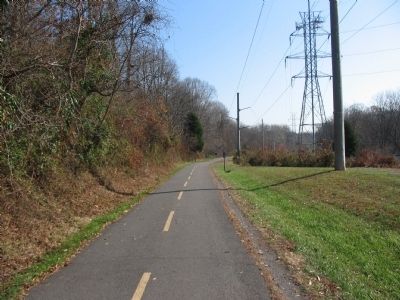Vienna in Fairfax County, Virginia — The American South (Mid-Atlantic)
Strategic Junction
Hunter Mill Road and the AL&H Railroad
Confederate General Robert E. Lee, Commander, VA Volunteers, recognizing the importance of the railroad and understanding it would be impossible for him to defend, ordered the destruction of the tracks on June 10, 1861. Even after the tracks were torn up west of Vienna it continued to be used as a foot and cavalry path by both Union and Confederate forces.
Hunter Mill Road was considered the "main road" northwards from Fairfax Court House, an important depot for the Confederates early in the war and the Union later on. Significant troop and cavalry movement took place past this spot throughout the war including to the great battles of Antietam and Gettysburg.
So important was this junction that Union Colonel Charles Lowell, Commander, 2nd Massachusetts Cavalry at Camp Vienna, set up an observation post overlooking the junction in 1863-1864. Colonel John S. Mosby's Partisan Rangers also recognized its significance. They conducted several successful raids against the post.
Crossroads Time Line
June 10, 1861 Gen. Robert E. Lee orders the destruction of the AL&H tracks to inhibit the advance of Union forces by rail from Alexandria. Train tracks are subsequently torn up and bridges burned west of Vienna.
June 17, 1861 George Washington Hunter, Jr., operator of Hunter's Mill, guides Confederate Col. Maxcy Gregg's regiment of 1st South Carolina Volunteers down the Alexandria Loudoun & Hampshire Railroad (AL&H) - today's W&OD Trail - to Vienna resulting in the well-known Railroad Ambush. It was the first tactical use of railroad in the war.
October 20, 1861 First military action in the Hunter Mill area occurs here as the Pennsylvania Reserve Corp's 1st Brigade called "Bucktails" engage Confederates fatally wounding a cavalryman.
November 26, 1861 Confederate Gen. J.E.B. Stuart's first engagement against Union cavalry occurs near the intersection of Lawyers and Hunter Mill Rds. This engagement is reported as the "Skirmish near Hunter's Mill" in "Harper's Weekly," December 21, 1861. Stuart's 1st N.C. Cavalry inflicts a 35 percent casualty rate on the 3rd Pa. Cavalry killing one lieutenant, wounding six men and capturing 26.
March 1862 The New Miller's House serves as a hospital for the "Bucktails" after the Battle of Dranesville.
Mid-March 1862 Approximately 15,000 men from Union Gen. George McCall's Pennsylvania Reserve Corps encamp and prepare for the upcoming Peninsula Campaign in the Hunter Mill Rd. corridor. With McCall are Gen. John Reynolds, 1st Brigade commander, who was the first general to perish at the Battle of Gettysburg; Gen. George Meade, 2nd Brigade commander, who was later given command of the Army of the Potomac just three days before Gettysburg; and Gen. Edward Ord, 3rd Brigade commander, who had defeated Stuart earlier at Dranesville.
September 3, 1862 Confederate Gen. Wade Hampton and his cavalry pass here protecting the right flank of Lee's Army of Northern Virginia on the way to the Battle of Sharpsburg (Antietam).
December 29, 1862 Stuart, along with then 1st Lt. John S. Mosby as scout, uses the railroad bed from Vienna to pass through here with forty prisoners on the well-known Christmas Raid. This raid also proves to be the genesis of Mosby's Partisan Rangers as Mosby and nine men were left behind to continue harassing Union forces.
June 17, 1863 The Union's 12th Corps eats breakfast here and receives orders to encamp 2-1/2 miles up Hunter Mill Rd., near the Colvin Run bridge while heading north towards Gettysburg.
June 26, 1863 Union Commander of the Army of the Potomac, Gen. Joseph "Fighting Joe" Hooker, and his staff pass here on the way to Gettysburg. An ongoing feud with army HQ's leads Hooker to resign the following day.
1863 to 1864 The Union picket post overlooking this junction suffers multiple successful attacks by Mosby's rangers. Most notably, on April 23, 1864, Mosby and 50 of his men cross Difficult Run, dismount and attack the pickets at 4 AM. One Union soldier is wounded; three men and nine horses are captured.
April 18, 1864 Herman Melville, author of "Moby Dick," accompanies Col. Charles Lowell's 2nd Mass. Cavalry out of Camp Vienna scouting for Lt. Col. Mosby. This mission results in Melville's poem "The Scout Toward Aldie."
October 18, 1864 Reverend John Read of Falls Church, is executed one mile east of here near mile marker 13.5 on the W&OD Trail.
Erected 2009 by Northern Virginia Regional Park Authority, Friends of the W&OD Trail, and Hunter Mill Defense League.
Topics and series. This historical marker is listed in these topic lists: Railroads & Streetcars • War, US Civil. In addition, it is included in the NOVA Parks, and the Washington and Old Dominion (W&OD) Railroad series lists. A significant historical month for this entry is March 1862.
Location. 38° 55.957′ N, 77° 18.286′ W. Marker is in Vienna, Virginia, in Fairfax County. Marker is on Hunter
Mill Road (County Route 674), on the right when traveling north. The marker is approximately 20 feet from the road along the W&OD Trail. Touch for map. Marker is in this post office area: Vienna VA 22182, United States of America. Touch for directions.
Other nearby markers. At least 8 other markers are within 2 miles of this marker, measured as the crow flies. Hunter’s Mill (here, next to this marker); Hunter Station (here, next to this marker); Crossroads to War (a few steps from this marker); Cartersville Baptist Church (approx. 0.8 miles away); Terror by the Tracks (approx. one mile away); Walking in the Footsteps of History (approx. one mile away); The Purpose of the Korean Bell Garden (approx. 1.1 miles away); The Bell of Peace and Harmony (approx. 1.1 miles away). Touch for a list and map of all markers in Vienna.
More about this marker. On the left side of the marker are portraits of Gen. Stuart, Col. Mosby, and a Pennsylvania Reserve Corps "Bucktail." A wartime photo is captioned, Clearing wreckage on the AL&H.
Also see . . .
1. Washington & Old Dominion Railroad. Wikipedia article offering details of the railroad and a list of stations. (Submitted on November 26, 2009, by Craig Swain of Leesburg, Virginia.)
2. Hunter's Mill Defense League. The League sponsored this marker. One of the organization's goals is to protect the scenic and historic character of the Hunter's Mill Road community.
(Submitted on November 26, 2009, by Craig Swain of Leesburg, Virginia.)
3. Friends of the W&OD Trail. General background on the trail and history. (Submitted on November 26, 2009, by Craig Swain of Leesburg, Virginia.)
Credits. This page was last revised on June 16, 2016. It was originally submitted on November 26, 2009, by Craig Swain of Leesburg, Virginia. This page has been viewed 3,123 times since then and 30 times this year. Photos: 1. submitted on November 26, 2009, by Craig Swain of Leesburg, Virginia. 2. submitted on November 27, 2009, by Craig Swain of Leesburg, Virginia. 3, 4, 5. submitted on November 26, 2009, by Craig Swain of Leesburg, Virginia.
